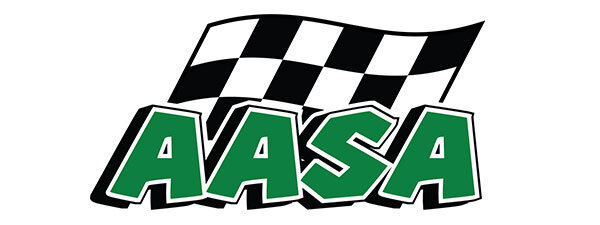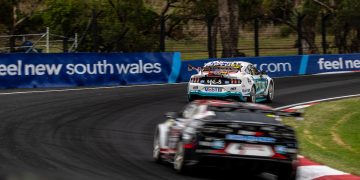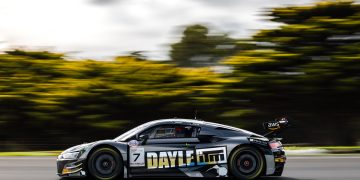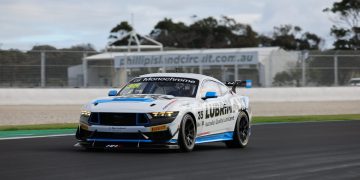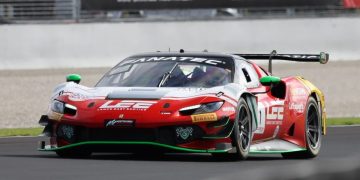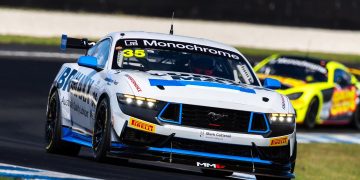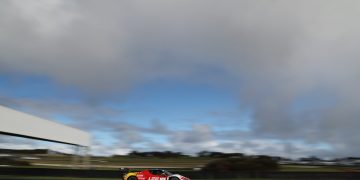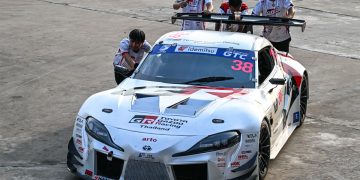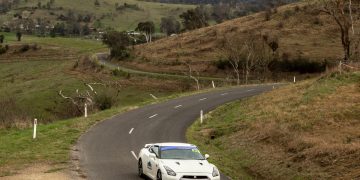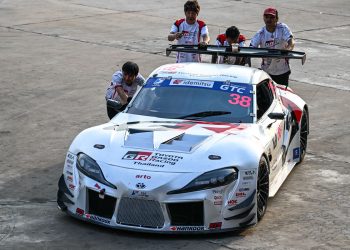 MEDIA RELEASE: Officially licensed with the ACO, the organisers of the annual Le Mans 24 Hours race, this sumptuous book is the sixth title in a decade-by-decade series that is building up into a multi-volume set covering every race.
MEDIA RELEASE: Officially licensed with the ACO, the organisers of the annual Le Mans 24 Hours race, this sumptuous book is the sixth title in a decade-by-decade series that is building up into a multi-volume set covering every race.
This title covers the seven 24 Hours races of the 1920s, plus, as a prologue, all the events held at the Le Mans circuit during the period 1906-23.
Each running of the 24 Hours is exhaustively covered in vivid photographs, an insightful commentary providing more detailed information than has ever been published about the period, and full statistics.
Complied by an acknowledged authority of this legendary race, this series of books is treasured by all enthusiasts of sports car racing.
This book covers the exciting era in which Bentley came to the forefront, winning in 1924 with a sabotaged car, in 1927 with a damaged car, in 1928 with a broken car, and in 1929 with a car that set an entirely new standard for Le Mans racers.
Woolf Barnato, the man whose wealth kept the company solvent, won twice, while Dudley Benjafield, ‘Tim’ Birkin, Frank Clement, Sammy Davis, John Duff and Bernard Rubin were the other ‘Bentley Boys’ who tasted success.
The victors in the other three years were French marques, Chenard-Walcker (in 1923) and Lorraine-Dietrich (in 1925 and 1926), and indeed French drivers and cars predominated in these early years, accounting for 220 of the 287 drivers and 38 of the 54 manufacturers that took part during the decade.
Amazingly, only five of the competing manufacturers – Aston Martin, Bentley, Bugatti, Chrysler and Peugeot – still exist.
The 24-hour event conceived by the Automobile Club de l’Ouest (ACO) was originally called the ‘Grand Prix de l’Endurance’ and run as an endurance trial for series-production cars rather than as a motor race.
But the teams went racing anyway and the event quickly matured into a unique challenge that fostered many advances in automotive engineering and technology – just as it still does today.
Aerodynamic bodies, front-wheel drive, air-cooled engines and four-wheel hydraulic brakes were tried and proven at Le Mans in this decade.
Such was the pace of change that the fastest average speed jumped from 57.21mph (92.06kph) in 1923 to 73.63mph (118.49kph) by 1929.
The rapid evolution of the cars is seen vividly in this book’s photographs, which also show year by year how the crowds grew, how the circuit infrastructure expanded and even how the track surfaces improved.
The opening phase of the history of the Le Mans 24 Hours has never been this thoroughly researched. Supported by 360 period photographs, many not published before, Quentin Spurring’s authoritative text relates all manner of adventures and describes the events in fact-packed depth, including a prologue devoted to previous races at Le Mans, starting with the Grand Prix de l’ACF of 1906.
This is a fascinating and richly detailed portrayal of the birth of the world’s greatest motor race.
The Author: Quentin Spurring has reported from the Le Mans 24 Hours on 26 occasions.
He has been editor of the British magazines Competition Car, Autosport, Racecar Engineering and The Paddock. His books have included five previous volumes of this Le Mans series (1949–59, 1960–69, 1970–79, 1980–89 and 1990–99) and the award-winning Grand Prix: Images of the First 100 Years.
Did You Know Facts:
You are welcome to use the ‘Did You Know Facts’ below, ensuring that you credit the author, book title and publisher
French benefit – 1923: The first event was almost exclusively a French affair: the only cars not coloured blue were a green Bentley from Britain and two yellow Excelsiors from Belgium.
By 1928 foreign makes outnumbered French ones for the first time, and a year later the top eight finishers were all British (Bentley and Lea-Francis) and American (Stutz and Chrysler).
The sawdust test – 1924: The public roads used for the circuit were very agricultural in the early years, but surfacing improved greatly during the decade.
Pre-event technical inspection in 1924 required each car to be driven over a tray of sawdust; if any was blown out of the tray, the scrutineers took the view that the exhaust pipe was pointing downwards too much, so that dust blown up from the road surface could cause visibility problems for drivers following.
Bentley’s first – 1924: The first Bentley success at Le Mans, with drivers John Duff and Frank Clement, was hard-won after a series of mechanical dramas – and an extraordinary attempt at sabotage.
Near the end, with plenty of time in hand, the car was brought into the pits for a precautionary change of its rear wheels, but one of them jammed on its hub so severely that half an hour was lost getting it off.
It turned out that someone had tampered with the hub – but W.O. Bentley ordered that this was never to be mentioned by anyone on the team.
Duff’s diet – 1924: Wearing his customary ‘plus-fours’, Bentley’s ace driver, Captain John Duff, arrived in the paddock before the start bearing a pillowcase containing a bag of fresh eggs, some lettuce and a jar of honey.
This was his intended diet after he had finished each driving shift, and he would swallow the eggs raw.
Trouble with landowners – 1925: For the 1925 event the ACO wanted to construct permanent facilities at the start/finish area, at the location still used to this day.
However, the owners of the land held out for their ambitious valuations, so the ACO, losing patience, decided simply to relocate all facilities – paddock, pits, race control tower, start-line grandstands – halfway down today’s Mulsanne straight.
This was a one-off: by 1926 the ACO owned the land it needed.
Birth of the ‘Le Mans start’ – 1925: The new start/finish facility – only used in 1925 – was also the birthplace of the famous ‘Le Mans start’.
For that year’s event every car was required to have a convertible hood, which the driver had to erect at the start and race for the first 20 laps with it raised.
The simplest way to prevent drivers from jumping the gun was to separate them from their cars: they lined up on the opposite side of the track and, when the start signal was given, sprinted across to their cars to erect the hoods, clamber in, start the engines and set off.
Good Samaritan – 1925: France’s Lorraine-Dietrich cars took the top two places in 1925, but the team’s third entry crashed at high speed and overturned while Léon Saint-Paul was driving.
In a chivalrous intervention, Italian driver Tulio Vesprini stopped at the scene and pulled Saint-Paul from the wreck, injured but alive.
Vesprini stayed with Saint-Paul until marshals and then an ambulance arrived, sacrificing his own chances of a strong placing. Post-race, the Lorraine-Dietrich team gave Vesprini FF1,000 as a reward.
Duff’s deception – 1925: After his Bentley ran out of petrol on the far side of the circuit, John Duff ran back to the pits and quietly informed his team, out of earshot of ACO officials looking on, that he was determined to keep going by fair means or foul.
Co-driver Frank Clement put some petrol in a lemonade bottle, which was discreetly handed to Duff behind the pits.
One of the mechanics, Walter Hassan, found a bicycle, but Duff was too tall to ride it properly, so Hassan jumped on (concealing the precious bottle) and cycled out to the abandoned car with Duff running alongside.
Although people had gathered near the Bentley, no one took much notice while Duff emptied the bottle into the tank, fired up the engine and headed to the pits for a fill-up.
A driver from the crowd – 1927: In 1927 the Tracta team’s four drivers were on their way to the circuit for the race when they were badly injured in a road accident and taken to hospital.
Despite his injuries, Jean-Albert Grégoire was so determined to race that he discharged himself from the hospital – by climbing out of a window – and took a taxi to the circuit.
As he needed a co-driver, a request was broadcast over the public-address system for someone in the crowd to step forward.
So it was that Lucien Lemesle, a mechanic, found himself an unexpected participant in the 24 Hours.
The American corner – 1929: Throughout the decade track surfaces were steadily improved, with new road-surfacing materials and techniques trialled.
In 1929 the left-hand turn ahead of Arnage corner was partially paved with bricks and given a name that it retains to this day – ‘Indianapolis’ after the brick-built American speedway.
For more information regarding the book, or to request a review copy or images, please contact: Rebecca/ Eventageous PR. T: 01452 260063 or email: [email protected]
About Evro Publishing: Evro Publishing publishes top-quality books at affordable prices, written by the finest authors and covering only the best subjects. As a publishing team they combine experience, skill and enthusiasm. www.evropublishing.co.uk. You can now follow Evro Publishing on Twitter @EvroPublishing


